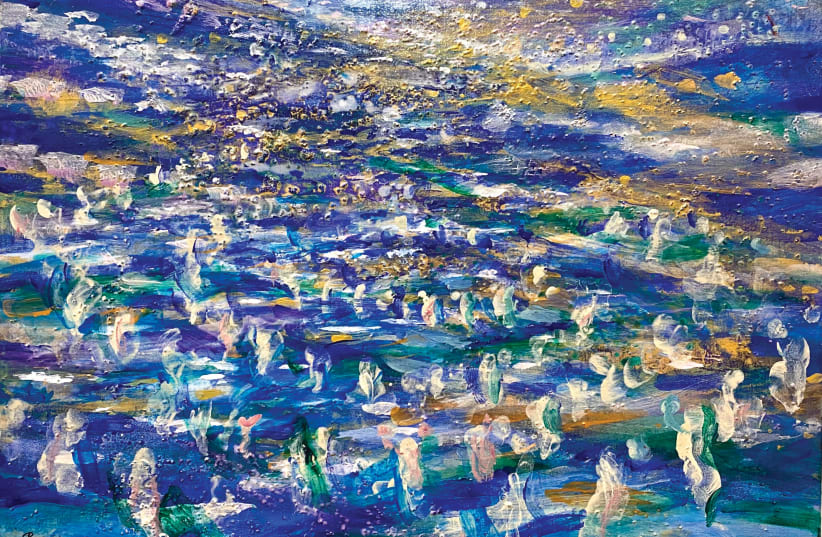“And Miriam the prophetess, the sister of Aaron, took a tambourine in her hand, and all the women went out after her with tambourines and danced. And Miriam called out to them, ‘Sing to God, for He has triumphed gloriously; He has thrown the horse and its rider into the sea’” (Exodus 15:20-21).
Miriam is referred to as the sister of Aaron because her prophecy began before Moses was born. According to the Talmud, she foretold that her mother would give birth to a boy who would lead the Israelite slaves to freedom. Now, after the crossing of the sea and the triumphant song of Moses and Israel, Miriam adds another level to the revelation at the sea by leading the women in singing and dancing to the sound of tambourines.
Many have wondered and commented on the difference between these songs. “The Song at the Sea” begins “Az yashir Moshe” (“then Moses will sing”). But Miriam’s song is written in the present tense, in the plural imperative – “Sing to God (now).” With tambourine in hand, the women danced with total liberation, in a way that would only be fully accessed again in the future.
The importance of music and dance in the story of the Exodus
We are surprised that the women had tambourines! It is hard to imagine that the women, rushing from their Egyptian homes in the middle of the night with only a few belongings and some matzah to eat, brought tambourines with them. But Rashi says that “the righteous women of that generation were so certain that God would do miracles for them, that they brought the tambourines with them from Egypt.”
Moses and the people sang together with joy “The Song at the Sea”; Miriam and the women added the element of dance. The Maharal (Rabbi Judah Loew ben Bezalel, 16th century) says that joy that remains in the heart is limited; but in dance, joy knows no bounds. The Baal Shem Tov taught that dance was tantamount to prayer and quoted the psalmist: “All my bones will exclaim, God, who is like You?” (Psalms 35:10). The Maor Veshemesh (Rabbi Kalonymus Kalman Epstein, 1753-1825) says that Miriam, in her dance, accessed a higher state of consciousness than Moses did through his song.
The Hebrew word used for dancing here is machol; the Mishna explains that machol means the circle dancing of the maidens on Tu B’av, which is described as one of the happiest days of the year. The same word is used in the Talmud when discussing how, in the future, the righteous will encircle God and praise Him (Tractate Ta’anit 31a). In the world to come, souls will enjoy being in God’s presence. The circle represents the endless joy the righteous will experience in the afterlife. Our sages tell us that this is the level of revelation that Miriam and the women experienced.
Sarah Yehudit Schneider writes that besides adding the element of dance, “Miriam gathered the women and fused them into a single collective kli [vessel] that was so powerful that it pulled down an even higher revelation of new light than Moshe drew down through his prophecy. For as great as Moshe was, an individual vessel is smaller than a collective vessel.
“Miriam’s circle of women drew the future into the present, initiating the Jewish nation into the secret truth, promise, and yearning of the circle world. The day will come, blessed and welcomed by all, when ‘knowledge of God will fill the Earth (and, by extension, the physical/material/body layer of ourselves) like the sea fills the ocean bed.’”
MIRIAM’S NAME comes from the Hebrew word mar (“bitter”), and she certainly experienced the bitterness of the Egyptian exile. An alternate explanation of Miriam’s name is that it comes from meri (“rebellion”). Despite being born into the most difficult period of oppression, Miriam rebelled from her earliest age against the slave mentality engulfing her people.
This was the strength of Miriam – a feminine strength born out of bitterness; a faith sowed amid despair. This was the strength of the women who left Egypt, equipped with tambourines and dances of joy and faith.
Yoram Raanan’s painting Transcendent Dance evolved over several years. According to the artist: “It kept evolving between sea and heaven. It was always both playing against each other.”
The painting has layers of blue, gold, and iridescent pearl. To these he added, with his fingers, a titanium buff with acrylic gel in shapes that suggest dancing figures, both human and angelic, revolving in circles as at the Reed Sea. The viewer senses a vantage overlooking a vast area, as if looking down from heaven. This perspective adds to the painting its transcendent quality.
The dance is also a flight. The painting not only intimidates the dance but is itself a dance.
As once again our people battle the forces of evil, women from all over the world are gathering – on Zoom! – for a Women’s Global Tambourine Dance on January 28. In the words of the Lubavitcher Rebbe: “Women, on the strength of their innately more deep-seated faith, should begin celebrating the redemption – even with music, dance, and drum.”
As the exodus from Egypt was brought about by the faith of the women, so too will be the future redemption.■
Meira Raanan is the author of Art of Revelation: A Visual Encounter with the Jewish Bible, a commentary on the paintings by her husband, Yoram Raanan. She also teaches Jewish meditation. Esther Cameron is a poet, scholar, and essayist living in Jerusalem. She is editor-in-chief of The Deronda Review.

